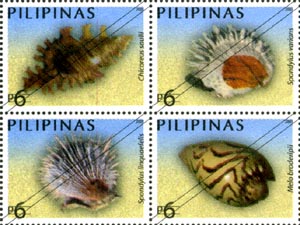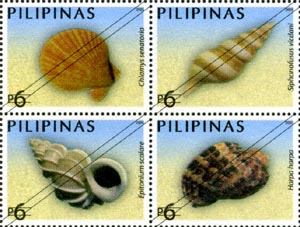 |
|
|
 |
|
|
|
|
 

|
| The Philippines has over
7,000 islands, and its coastline is longer than that of the United States.
Being the oldest coral reef formation in the world, it is no wonder that
we are very rich in marine life, especially seashells. There were so many
shells new to science being discovered and named in our country in the
past 25 years. Recently, there are many more under study by conchologists
all over the world. We should be encouraged to move forward to further
study our heritage beneath our seas. For this first series, the following
Philippine shells are featured. On the stamps:
Chicoreus saulii - Reddish in color, it is similar to Chicoreus palmarosea. It is a deep water shell and is uncommon. It is usually 3" to 4" in size. Spondylus varians - This species is known to have a salt water trapped in its valve, covered with a thin calcareous membrane. It is also called the "Water Spondylus" and comes in red, orange and yellow. Spondylus linguaefelis - A deep-water shell known to be found only in Hawaii before. Recently, many were also discovered in the Philippines. Melo broderipii - it ranges from 5" to 12" in size. Normally cream-colored, without any patterns. The soft parts are used for food in the provinces. Chlamys senatoria - This was a " hard-to-find" shell many years ago. Due to its excellent taste, it is now cultured by the millions and canned for export. Siphonpfusus vicdani - This shell is about 3 1/2" in size, and is found in the island of Balud, Davao. It was taken by tangle net at a depth of 600 feet and named in 1992. Live specimens are rare. Epitonium scalare - This was extremely rare in the early 20th century. Collectors exchange gold and silver for it. Now, thousands are found in the muddy waters of Manila Bay. Harpa harpa - Aso known as Harpa nobilis. The strong axial ribbing resembles a harp, so it was thus named. It is usually 2" in size. On the souvenir sheet: Siliquaria armata - It is commonly called the "worm shell". Sometimes they grow together and form a ball of 4" to 6" in diameter. Argonauta argo - Commonly called "Paper Nautilus". A size of 9" or larger is rare. Normal size is about 6". It is actually an egg casing of a female mollusk. The male with tentacles looks like an octopus or squid. Perotrochus vicdani - This shell was discovered in 1980 in Panlao Island of Bohol, at a depth of over 600 feet. Its size is 2" to 2 1/2". Corculum cardissa - Due to its shape, it is called "Heart Shell". Pure white ones are common, although colored ones are occassionally found. |
|
|